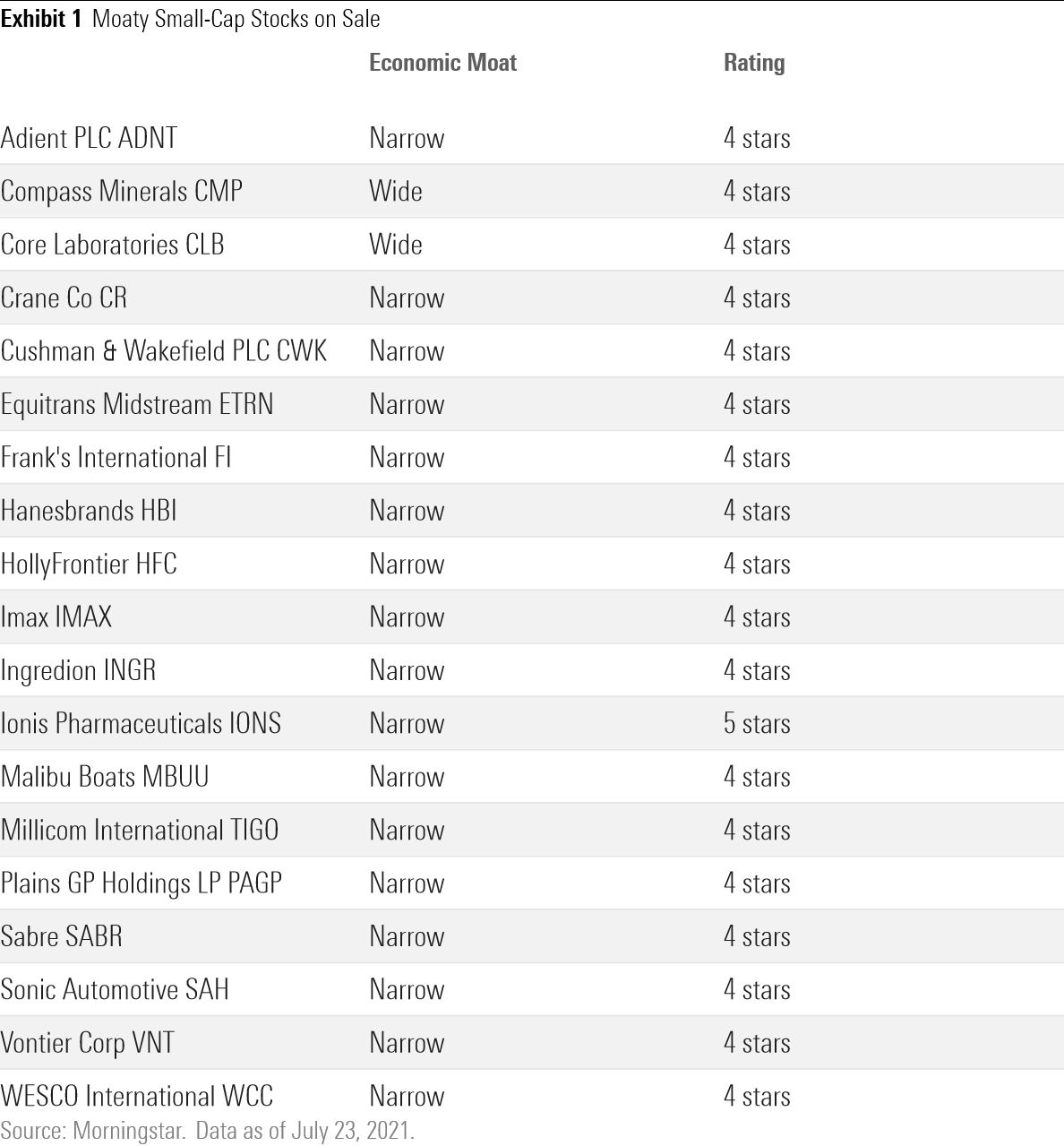19 Elite Small-Caps on Sale
These wide- and narrow-moat small companies are undervalued according to our metrics.

The past 12 months have been good to smaller companies: The Morningstar US Small Cap Index has outpaced the Morningstar US Large Cap Index by more than 8 full percentage points during the period. However, the return picture over the trailing three-year period suggests that small companies may still have room to run: They lag their large-cap counterparts by more than 9 full percentage points during that timeframe. Moreover, according to the Morningstar Market Fair Value graph, the average small-cap stock we cover is about fairly valued while the average large-cap stock is about 8% overpriced.
Today, we're looking for undervalued, high-quality small companies. Specifically, we've screened for companies with wide or narrow Morningstar economic moat ratings that land in the small-cap portion of the Morningstar Style Box and that are trading in 4- and 5-star range. Nineteen names made the cut.

Here’s what our analysts have to say about three of the companies on the list.
Adient ADNT "Adient is the automotive seating business of Johnson Controls that was spun off to JCI shareholders in a taxable transaction Oct. 31, 2016. Adient leads the seating market with about 33% share globally. It is common for a spin-off to be ignored or misunderstood, but we think ignoring Adient just because it is an auto-parts supplier is shortsighted. Seating is one of the stickiest parts of the supplier sector since it is very difficult to take out an incumbent on a vehicle program, and automakers need suppliers that can consistently deliver high-quality seats in a just-in-time system all over the world. Automakers have global platforms and are willing to pay for the right supplier rather than the supplier simply with the lowest price. We think the seating sector can benefit from autonomous and electric vehicles rather than be hurt by the change because AVs and EVs open up new seating configurations and possibly more electronics content in seats.
We think some investors may need to reframe their perspective on the seating and auto suppliers space by understanding that seating is not a commodity product and that firms such as Adient have a narrow economic moat with sustainable competitive advantages from three moat sources: intangible assets, switching costs, and cost advantage. It is normal in the seating space, for example, that an incumbent supplier gets the next generation of a vehicle program nearly 100% of the time.
Adient is in the process of consolidating some of its Chinese seating joint ventures so it can pursue business with more Japanese, German, and startup electric vehicle firms. We think the company can increase operating margin including equity income over the next several years by restructuring its operations to be a better manufacturer and asset sales of some Chinese joint ventures is giving good cash flow to reduce debt of about $3.6 billion. Management also formed a joint venture with Boeing BA in January 2018 focused on business-class seats, of which Adient owns 19.9%. For patient investors who can wait for the company to restructure itself, we see Adient as an interesting turnaround story capable of eventually generating good free cash flow." David Whiston, sector strategist
Crane CR "Crane owns a portfolio of moaty businesses that tend to be leaders in their niche markets, typically holding the number one or two market share position. It makes a wide range of products, including valves, banknote validators, and aerospace components, but a common thread across its portfolio is that Crane manufactures highly engineered products that often perform a mission-critical function. Crane has consistently generated solid returns on invested capital, averaging around 13.5% over the past 10 years, and we think that as the global macroeconomic environment normalizes, the company is well positioned to continue outearning its cost of capital thanks to its narrow moat.
We think Crane has built a moat around its business based primarily on intangible assets, including its engineering prowess and reputation for quality and reliability. Furthermore, we believe that Crane benefits from customer switching costs associated with its large installed base of equipment. For instance, the firm’s brake control systems have been used in all of Boeing’s commercial aircraft that are currently in operation, and the firm enjoys an entrenched position with other key original equipment manufacturers. In the payment & merchandising technologies segment, the recently acquired Crane Currency has strong relationships with over 50 mints and treasuries, and the business has supplied currency paper to the U.S. Treasury for more than a century. Lastly, process flow technologies benefits from its large installed base because customers tend to be risk-averse and often replace products like-for-like.
Crane generates healthy cash flows that allow it to reinvest capital in organic growth, driven by introductions of new and improved products as well as acquisitions. Although we don't explicitly model unannounced acquisitions, we expect that Crane will continue to pursue M&A to help boost organic growth. We think that future acquisitions will likely focus on complementing the firm's existing portfolio and strengthen its core business in the process flow technologies and aerospace & electronics segments." Krzysztof Smalec, analyst
Imax IMAX "In the middle of the 2000s, Imax reinvented itself by embracing the digital video revolution, allowing the firm to digitally remaster blockbuster films into its proprietary large-screen format. Imax is now the dominant player within the premium large-format cinema marketplace and, in our view, has carved out a narrow economic moat.
Imax has leveraged its format standards and technologies, including its projection systems and digital film conversion process, to capture over 50% market share within the premium large-format cinema marketplace. This switch from films shot only with Imax cameras helped the firm expand from 210 theaters in 2008 to over 1,650 in 81 countries today, increasing the annual Imax releases from 13 in 2007 to 60 in 2019. Imax is now primarily a technology hardware and brand-licensing company that does not operate the vast majority of Imax theaters. Instead, the firm generates revenue by selling and leasing the required proprietary equipment and via fees for digitally remastering standard films into the proprietary Imax format. While expensive, Imax screens boast average annual gross revenue of around $750 million (pre-pandemic), well above the per-screen average of traditional screens.
A higher percentage of new theaters for the company now fall under a joint revenue-sharing arrangement, under which Imax receives a larger percentage of box-office receipts (typically 19%-20%) versus a traditional sales-lease agreement. We believe that most of these agreements (generally 10-year terms with three- to five-year renewal options held by theater owners) will be renewed, but the first real test of this thesis will not occur until 2022." Neil Macker, senior analyst

/s3.amazonaws.com/arc-authors/morningstar/35408bfa-dc38-4ae5-81e8-b11e52d70005.jpg)
/cloudfront-us-east-1.images.arcpublishing.com/morningstar/T5SLJLNMQRACFMJWTEWY5NEI4Y.jpg)
/cloudfront-us-east-1.images.arcpublishing.com/morningstar/KNTMDTIW3JFWJBYCASLAV3ZIJE.jpg)
/cloudfront-us-east-1.images.arcpublishing.com/morningstar/D2M6HBDLIZD3RLWRUR7IPUIVIU.jpg)
:quality(80)/s3.amazonaws.com/arc-authors/morningstar/35408bfa-dc38-4ae5-81e8-b11e52d70005.jpg)